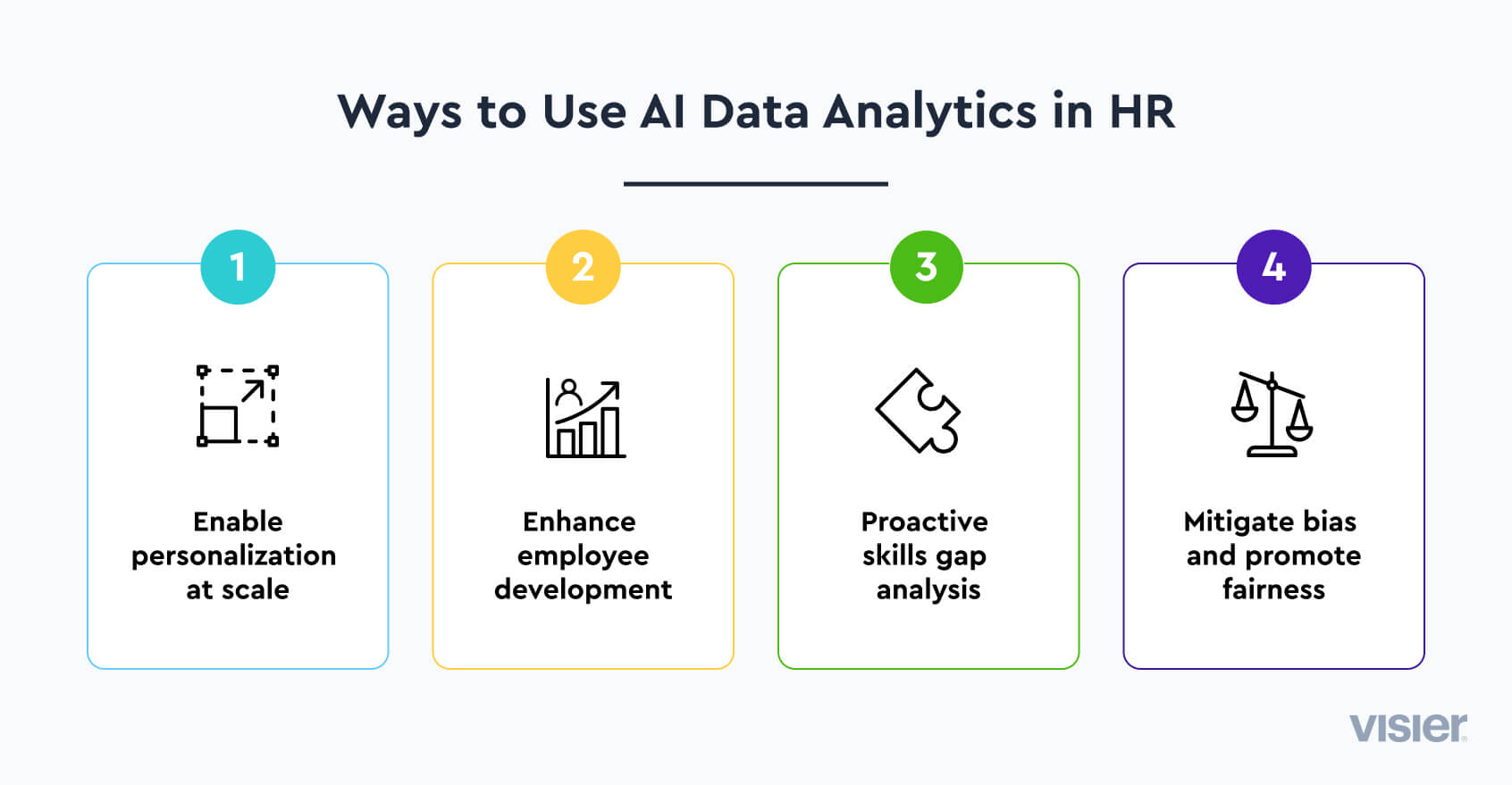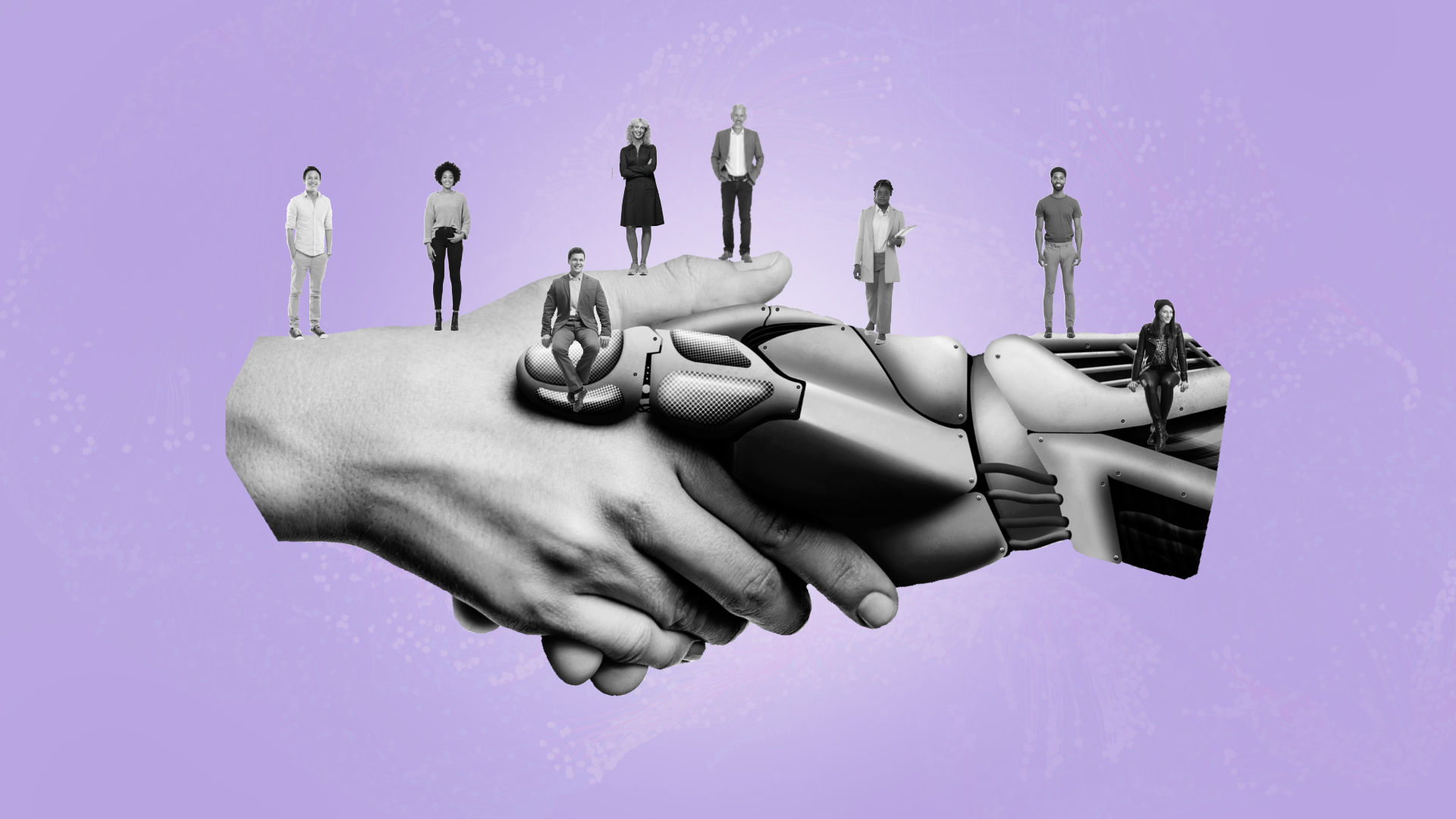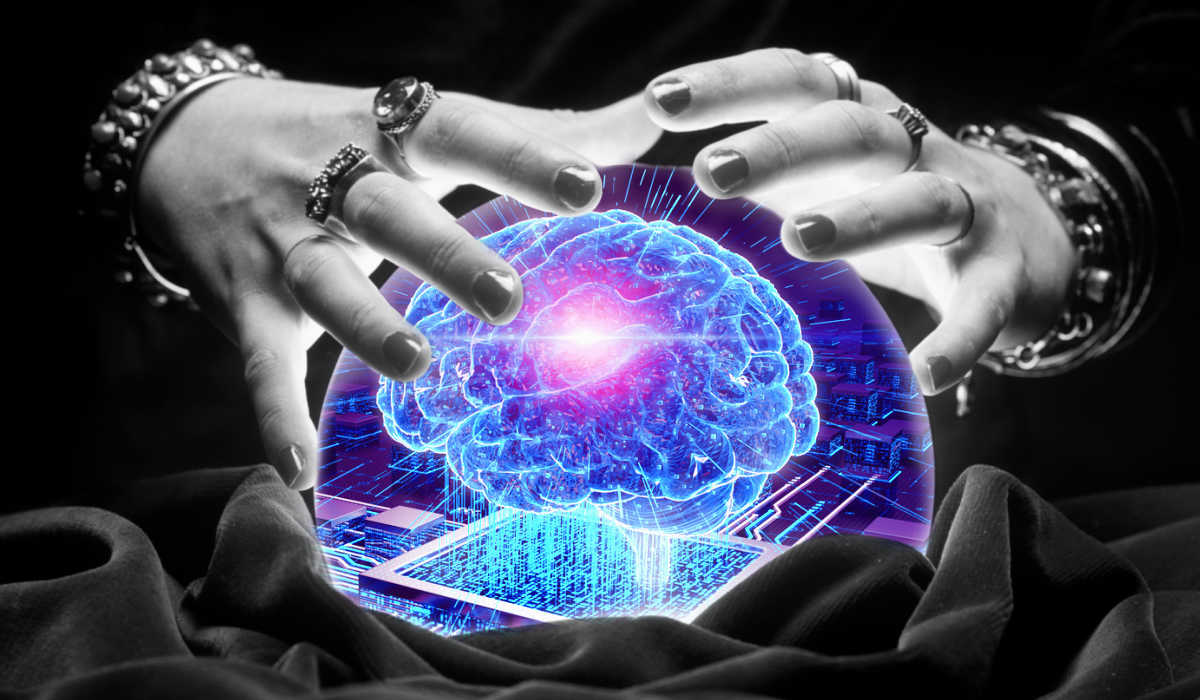ARTIFICIAL INTELLIGENCE
How To Use AI Data Analytics in HR
AI data analytics makes it easier for HR leaders to access key insights to make more informed, objective, and evidence-based decisions across various HR functions. Learn how to use AI data analytics in HR here.
Get a Demo
Table of contents
What is AI data analytics?The power of people analytics and AI data analyticsChallenges and ethical considerationsUsing AI data analytics to make data-driven HR decisionsWhat is AI data analytics?
AI data analytics are transforming how HR professionals access insights to make data-driven decisions. By leveraging AI algorithms, HR teams can extract valuable insights from complex datasets that would be challenging, time-consuming, and even impossible for humans to process manually. This empowers HR leaders to make more informed, objective, and evidence-based decisions across various HR functions.
AI data analytics offer the opportunity to:
Handle big data. AI helps HR departments generate and analyze vast amounts of data from various sources like applicant tracking systems, performance management tools, employee surveys, and HRIS platforms. AI excels at processing big data by quickly sorting, organizing, and structuring the information for analysis.
Identify patterns and trends. It’s not just about crunching the numbers. AI algorithms can identify patterns and trends within HR datasets that might not be otherwise apparent to human analysts. This can include recognizing correlations between employee attributes and performance, identifying factors influencing employee turnover, and predicting future workforce needs.
Generate predictive analytics. AI data analytics goes beyond descriptive analysis by incorporating predictive modeling. HR teams can use AI to help forecast future trends such as the likelihood of an employee leaving the company or the potential impact of specific HR-related interventions.
Natural language processing (NLP). Through NLP, AI is able to understand and analyze unstructured data such as employee feedback, sentiment analysis from employee surveys, and even casual interactions on collaboration platforms. Emerging generative AI tools are changing how HR teams and employees can access information.

Using AI data analytics to improve HR operations
HR teams can leverage AI data analytics to streamline and improve myriad HR functions, from resume screening to new employee onboarding. Here are a few examples of how teams can use AI data analytics:
Resume screening: Teams can use AI data analytics when analyzing and filtering through large volumes of resumes and applications to identify potential candidates based on specific criteria.
Employee performance analysis: Use AI data analytics to monitor and analyze employee performance metrics like productivity, efficiency, and goal achievement and identify high performers as well as areas of opportunity for improvement.
Workforce planning: AI can analyze historical data to predict future workforce requirements, helping HR practitioners plan for recruitment, training, and development needs.
Employee engagement and satisfaction: AI can be used to analyze employee feedback from surveys and other sources to identify areas of improvement or concern.
Training and development: AI-powered learning platforms can personalize training content and delivery methods based on individual learning needs, styles, and preferences.
That’s really just the tip of the iceberg. As HR professionals gain experience with AI data analytics, and as the technology continues to evolve, new applications will continue to emerge.
The power of people analytics and AI data analytics
People analytics allows business leaders and people managers to make better-informed people decisions during hiring, compensation reviews, internal movement, and promotions. It can also mitigate risks and ensure compliance when coupled with learning and development options.

AI data analytics can enhance people analytics capabilities in a variety of ways, including:
1. Personalization at scale.
AI data analytics offers organizations the opportunity to personalize various aspects of the employee experience—from training and development, to benefit administration—across the organization.
For instance, AI-driven chatbots and virtual assistants will make it possible for employees to receive tailored HR support that might include personalized learning and development plans, benefit recommendations, career guidance, and more. AI algorithms can also be used to segment employees based on a wide range of criteria, like performance and career goals, to help facilitate targeted interventions, personalized learning and development, and customized career paths.
2. Enhance employee development
AI data analytics can be used to support a culture of continuous learning and improvement. AI data analytics in HR can be used to enhance employee training and L&D programs and recommend learning paths for individual employees based on their performance and career goals. Additionally, it can be used to identify employees who may be at risk of turnover, allowing HR to implement interventions as appropriate—such as career development opportunities or personalized benefits.
3. Proactive skills gap analysis
Using AI to analyze employee skills data can help HR leaders identify skills gaps, allowing leaders and managers to pinpoint where they need skills and implement targeted training programs more effectively. AI can identify employees who have expressed interest in expanding their skill sets and candidates or have shown potential for growth in specific areas, as well as employees who are good candidates for upskilling and reskilling initiatives.
4. Mitigate bias and support DEIB goals
AI algorithms will evolve to better detect and mitigate bias in HR processes across the employee lifecycle. In recruiting cycles, AI algorithms may be able to detect bias and create bias-free written content for job descriptions, ensuring fair treatment throughout the HR lifecycle. AI data analytics may also be used to identify bias in performance evaluations and compensation programs.

Challenges and ethical considerations
AI data analytics in HR has many benefits but there are potential challenges and limitations that should be considered. Here are the main ones:
Data quality and bias: the accuracy and reliability of AI analysis are only as good as the data it uses. Biases in the data can perpetuate themselves in AI algorithms, for example, if there has been historical bias in hiring or performance evaluations.
Privacy and security: HR data contains sensitive information about employees such as personal details, performance evaluation information, and health data. Data privacy and security must be ensured to prevent data breaches and unauthorized access. It's critical to use AI tools with a robust, reliable security model that can protect sensitive people data.
Interpretability and transparency: AI algorithms can be complex and difficult to interpret, which can raise concerns about transparency and accountability. HR professionals may need help to understand how AI came up with specific conclusions or recommendations.
Adoption and resistance: Some HR professionals may be skeptical about AI adoption. Resistance to change, fear of job displacement, or a lack of understanding about AI can all threaten the successful integration of AI into HR practices.
Overreliance on technology: While AI can provide valuable insights, an overreliance on technology can neglect the human touch in HR decision-making. The profession is called human resources for a reason: human judgment, empathy, and contextual understanding should not be replaced by AI-driven analyses, but should be augmented by them. Ultimately, HR decisions impact people and need to be well-informed by both AI analysis and human considerations.
Using AI data analytics to make data-driven HR decisions
AI data analytics can improve many areas of your business. Regardless of where and how you want to use it, your first step should always be to look at the people in your company. People analytics is an effective tool when you want to take the people data you have and turn it into valuable insights. You’ll gain a deeper understanding of your workforce and you’ll make data-driven decisions in every area of your business.
To take the power of people analytics one step further, Visier created Vee, an AI digital assistant that helps gain more meaningful insights and interpret data correctly. Vee simplifies people analytics with a conversational interface that complements charts and graphs.
Once you have the data that matters, you can start focusing on other pressing issues and use the power of AI to dig deeper. One of the critical aspects of any business is talent retention.
Use data to understand what drives your employees, what motivates them to always do better, and what will make them stay with the company. AI analytics can take this process further by predicting flight risk, identifying engagement drivers, and creating personalized career plans.


